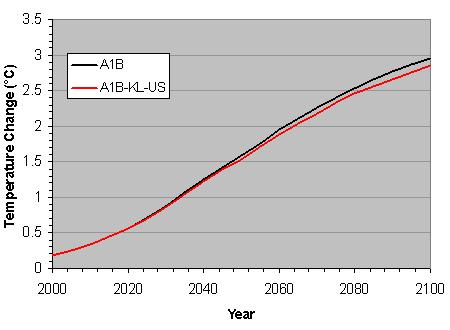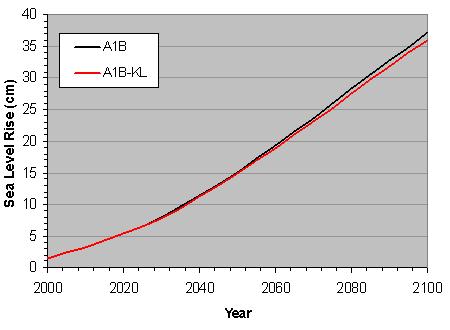by Chip Knappenberger
May 12, 2010
Senators John Kerry and Joseph Lieberman have just unveiled their latest/greatest attempt to reign in U. S. greenhouse gas emissions. Their one time collaborator Lindsey Graham indicated that he did not consider the bill a climate bill because "[t]here is no bipartisan support for a cap-and-trade bill based on global warming." But make no mistake. This is a climate bill at heart, and thus the Kerry-Lieberman bill sections labeled "Title II. Global Warming Pollution Reduction."
So apparently someone thinks the bill will have an impact on global warming. But those someones are wrong. The bill will have no meaningful impact of the future course of global warming.
That is, unless the rest of the world - primarily the developing nations - decide to play along.
In fact, the United States and the rest of the developed countries have little role to play in the future course of global warming except as developers of new energy technologies and/or as guinea pigs of making do with less fossil fuels.
Our attempts at domestic emissions savings will have only minimal direct climate impact, but instead they will serve as an example for the developing world of what, or what not, to do. So if Kerry and Lieberman were interested in directly tackling the climate change issue, they would be working with China's National People's Congress to draft legislation to reduce greenhouse gas emissions, not the U. S. Senate.
But, everyone already knows this, as we demonstrated the non-impact of U.S. emissions reduction efforts in Part I and Part II of our analysis of last summer's Waxman-Markey offering. And as far as the global warming goes, Kerry-Lieberman's The American Power Act of 2010 is similar to Waxman-Markey's American Clean Energy and Security Act of 2009.
Kerry-Lieberman's domestic greenhouse gas emissions reduction schedule is 17% below 2005 emissions levels by 2020, 42% below by 2030, and 83% below by 2050. Compare that to Waxman-Markey's 20% reduction in emissions (below 2005 levels) by 2020, 42% by 2030, and 83% by 2050. Except for a bit of relaxation of near term targets, the bills' long-term intentions are identical.
The impact of this slight emissions difference on the resulting future global temperature savings is not manifest until the third digit past the decimal point - in other words, thousandths of degrees C. Climatologically, in other words, the bills are identical.
As in our prior analyses, we use the same techniques employing a climate model simulator to derive global temperature (and sea level) projections from the greenhouse gas emissions scenarios. We use the Intergovernmental Panel on Climate Change's (IPCC) "business-as-usual" scenario (A1B) as the baseline, and then modify it to take into account the Kerry-Lieberman emissions targets for the U.S.
Figure 1 compares the global temperature projections from the business-as-usual (BAU) scenario with the Kerry-Lieberman adjustments. The BAU scenario produces a temperature rise (over the 1990 global average temperature) of 1.584 degree C by the year 2050 and 2.959 degree C by 2100. The Kerry-Lieberman adjustments produce a temperature rise of 1.541 degree C by 2050 and 2.848 degree C by 2100.
 | Figure 1. Projected global temperature rise from the IPCC's business-as-usual (A1B) scenario (black curve) and the Kerry-Lieberman emissions scenario (red curve). |
The global temperature "savings" of the Kerry-Lieberman bill is astoundingly small - 0.043 degree C (0.077 degree F) by 2050 and 0.111 degree C (0.200 degree F) by 2100. In other words, by century's end, reducing U.S. greenhouse gas emissions by 83% will only result in global temperatures being one-fifth of one degree Fahrenheit less than they would otherwise be. That is a scientifically meaningless reduction.
Figure 2 shows that the impacts on future sea level rise projections are equally insignificant. Instead of a projected sea level rise of 15.1cm by 2050, the Kerry-Lieberman bill produces a rise of 14.9cm. By 2100, the BAU projected rise is 37.1cm and the Kerry-Lieberman rise is 36.0cm. A century's end sea level rise savings of 1.1cm, or 0.43 inches. Too small to be of consequence.
 | Figure 2. Projected global sea level rise from the IPCC's business-as-usual (A1B) scenario (black curve) and the Kerry-Lieberman emissions scenario (red curve). |
As I mentioned previously, the real impact of the Kerry-Lieberman bill only emerges if it is applied to the rest of the world, and in particular the world's developing nations.
Figure 3 shows the global temperature projections from the BAU scenario, along with the successive adherence to the Kerry-Lieberman emissions schedule by the U.S., the OECD90 countries (industrialized countries including the U.S., Western Europe, Australia and Japan), and the entire world. Basically, unless the developing world comes on board, the world's future temperature pathway will be largely unchanged.
 | Figure 3. Projected global temperature rise from the IPCC's business-as-usual (A1B) scenario (black curve) and the Kerry-Lieberman emissions scenario as applied to the U.S. (red curve), the OECD90 countries (magenta curve), and the entire world (blue curve). |
Granted, all my numbers may change a bit if different assumptions are made about the baseline scenario, the particulars of international cooperation, or the various parameters of the climate model simulator (for example, I used a climate sensitivity of 3.0 degree C). But the bottom line will remain the same - climatologically, the Kerry-Lieberman American Power Act, in and of itself, is a meaningless bill. To make it effective, it must involve the world's developing counties.
Original Article